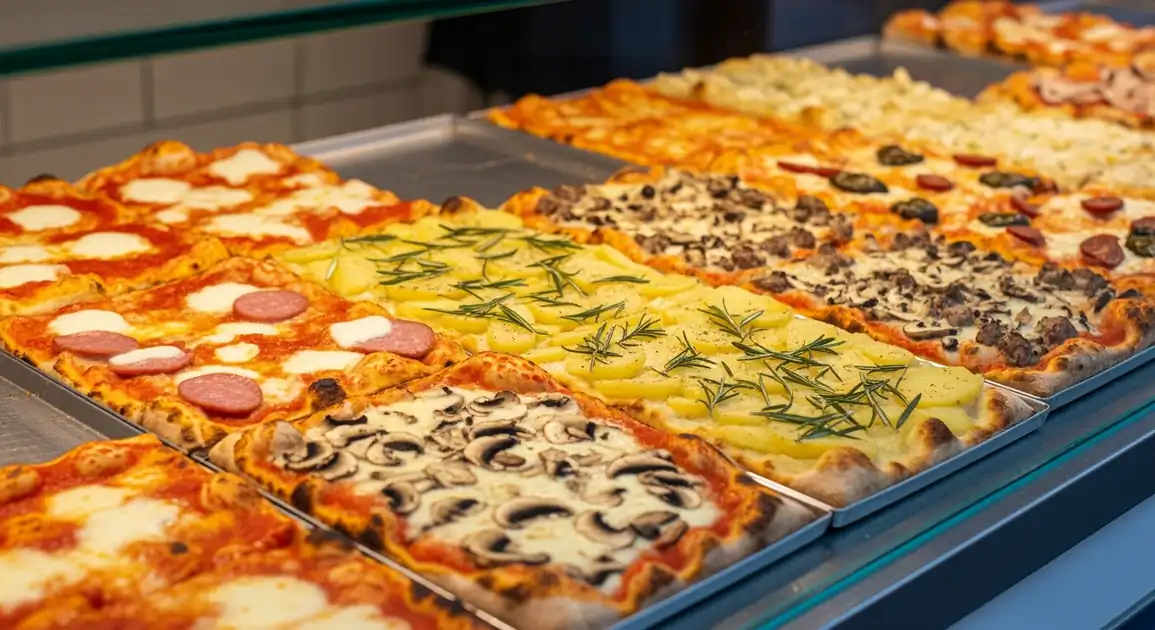Pizza al Taglio (Pizza by the Slice)
Pizza al Taglio

Description
Pizza al Taglio is found throughout Italy, especially in cities, serving as a popular, quick, and affordable lunch or snack. While Rome is its spiritual home with the widest variety and highest concentration of dedicated shops ('pizzerie al taglio' or 'forni'), quality examples exist nationwide, sometimes adapted with local ingredients or styles.
Dietary Information
Serving information
Serving style
Served warm, often on a piece of paper or cardboard tray. Typically eaten standing at a counter, sitting on nearby steps, or walking. Consumed informally.
Quick facts
Typically open from mid-morning (around 10 AM) through the afternoon (until 7 PM or 8 PM), some close midday, others stay open later.
Safety Tips
What to Look For
-
High customer turnover.
Busy shops sell pizza quickly, ensuring it's fresh and hasn't been sitting at room temperature for extended periods.
-
Fresh-looking, vibrant toppings.
Toppings should look recently prepared, not dried out, wilted, or discolored. Cheese should look properly melted, not congealed or oily.
-
Crispy, golden-brown crust base.
Indicates proper baking and freshness. A soggy base can suggest it's old or wasn't baked correctly.
-
Clean counter, cutting tools, and serving area.
Basic hygiene is essential. Look for clean surfaces, tongs/spatulas, and vendor hygiene.
-
Option to reheat the slice ('Lo scalda?').
Reheating briefly in a hot oven not only improves taste and texture but also helps ensure it's served hot, reducing potential bacterial growth.
What to avoid
-
Pizza that looks like it's been sitting out for hours.
Increased risk of bacterial growth and degraded quality (dry toppings, soggy crust).
-
Dried out, sparse, or dull-looking toppings.
Indicates lack of freshness and poor quality.
-
Soggy or pale crust underneath.
Suggests poor baking, old pizza, or absorption of moisture over time.
-
Visible flies, pests, or general uncleanliness around the food display.
Clear sign of poor hygiene standards.
-
Vendors handling money and food without washing hands or changing gloves.
Risk of cross-contamination.
Price information
Price range
Budget tips
- Pizza Rossa and Pizza Bianca are usually the cheapest options.
- Prices are by weight (typically 15-35 EUR per kilo), so a larger-looking piece with lighter toppings (like potato) might cost less than a smaller piece with heavier toppings (like sausage).
- Look for simple bakeries ('forno') slightly off main tourist routes for potentially better value.
Value indicators
- Price clearly displayed per kilogram ('al kg' or '/hg' for 100g).
- High-quality ingredients visible (fresh mozzarella, vibrant vegetables).
- Good crust structure (airy inside, crispy base).
- Busy location indicating freshness.
Where to Find This Dish
City Centers
Abundant near train stations, universities, busy commercial streets, and markets.
Main squares, Train stations
Lunchtime, Late Afternoon
Bakeries ('Forno')
Traditional bakeries often dedicate counter space to pizza al taglio.
Local neighborhood bakeries
Morning, Lunchtime
Vendor Tips
- Don't be shy to ask 'Qual è la specialità della casa?' (What's the house specialty?).
- Observe where locals are queuing, it's usually a reliable sign of quality.
- Specify if you want the slice reheated ('Me lo scalda, per favore?').
How to Order
Regional Variations
-
Pizza Rossa
(Pizza Rossa)
'Red Pizza'. Simply topped with tomato sauce, olive oil, salt, and sometimes oregano. A classic Roman bakery staple.
-
Pizza Bianca
(Pizza Bianca)
'White Pizza'. No tomato sauce. Typically dressed with olive oil, salt, and often rosemary. Can be eaten plain or used for sandwiches.
-
Margherita
(Margherita)
Tomato sauce, mozzarella cheese, and basil. The quintessential pizza topping.
-
Patate e Rosmarino
(Patate e Rosmarino)
Thinly sliced potatoes (sometimes par-cooked) and fresh rosemary, often on a bianca base. Surprisingly delicious.
-
Fiori di Zucca
(Fiori di Zucca)
Zucchini flowers, anchovies, and mozzarella. A beloved Roman specialty, seasonal (usually Spring/Summer).
-
Salsiccia
(Salsiccia)
Crumbled Italian sausage, often paired with mozzarella or broccoli rabe ('friarielli').
-
Funghi
(Funghi)
Mushrooms, usually sautéed with garlic and parsley, on a tomato or bianca base with mozzarella.
Cultural context
History
While hearth-baked flatbreads are ancient, Pizza al Taglio in its modern form gained prominence in Rome, likely in the post-WWII era. Bakeries ('forni') began utilizing their large ovens and dough expertise to create these rectangular pizzas as an affordable, satisfying food for workers. Its convenience and variety fueled its popularity, making it ubiquitous across Rome and spreading throughout Italy.
Local significance
Represents a democratic, accessible, and delicious part of modern Italian food culture. A go-to quick meal for students, workers, and tourists alike.
Eating customs
- Often folded ('a libretto') to eat on the go, though thicker slices are harder to fold.
- Consumed quickly, standing up or perched somewhere nearby.
- No formal table setting required.